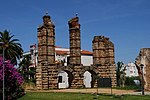Acueducto de los Milagros
Aqueducts in SpainBridges in Mérida, SpainHistory of ExtremaduraRoman aqueducts outside RomeRoman bridges in Spain ... and 2 more
Tourist attractions in ExtremaduraWorld Heritage Sites in Spain

The Acueducto de los Milagros (English: Aqueduct of the Miracles) is a Roman aqueduct in Mérida (Badajoz), Spain. It was built during the first century AD to supply water from the Proserpina Dam to the ancient Roman colony of Emerita Augusta. After the fall of the Roman Empire, the aqueduct fell into decay and today it is in ruins with only a relatively small section of the aqueduct bridge standing. The Archaeological Ensemble of Mérida, including the aqueduct, was declared a UNESCO World Heritage Site in 1993.
Excerpt from the Wikipedia article Acueducto de los Milagros (License: CC BY-SA 3.0, Authors, Images).Acueducto de los Milagros
Calle Ribera, Merida Carcesa
Geographical coordinates (GPS) Address Nearby Places Show on map
Geographical coordinates (GPS)
| Latitude | Longitude |
|---|---|
| N 38.924444444444 ° | E -6.3466666666667 ° |
Address
Calle Ribera
Calle Ribera
06800 Merida, Carcesa
Extremadura, Spain
Open on Google Maps











